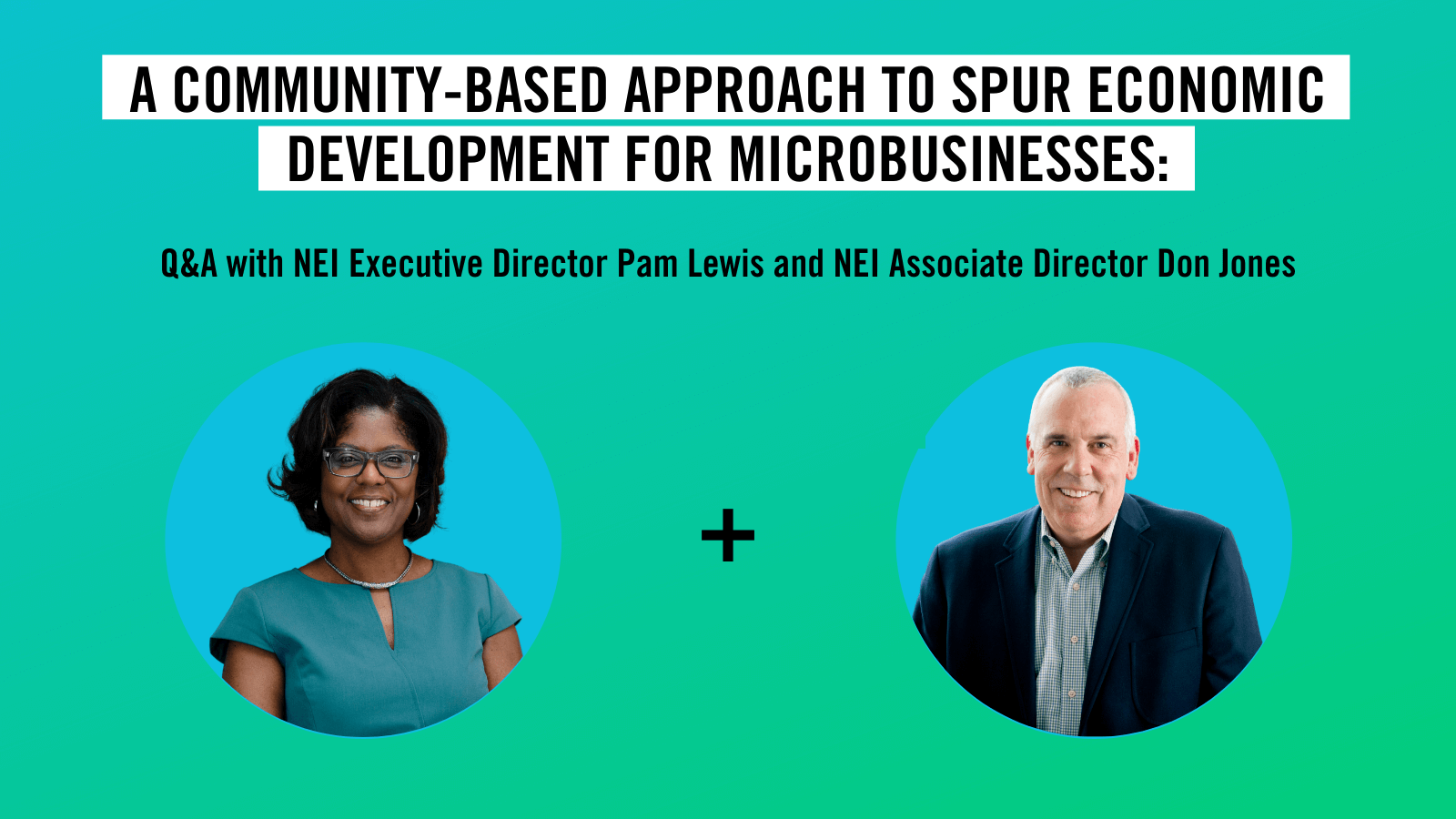
Pam Lewis, NEI executive director, and Don Jones, NEI associate director, recently sat down to discuss how any city might engage a community-based approach to spur economic development for microbusinesses. Melinda Clynes, writer, recorded their conversation.
If a city has limited resources, what are the top five actions that can be taken with little to no resources to support small businesses in underserved communities?
When we both started at NEI in 2009 and 2010, that’s where we were. There was a recession in the state, and the City of Detroit was moving into bankruptcy. There was little municipal infrastructure and little support available for small businesses. So, we have some understanding of this position, and definitely have some suggestions.
First of all, identify what small businesses you really want to focus on because the definition is so broad. Which small businesses matter to your community and economic development strategy? For example, here in Detroit, NEI first focused on high-growth businesses and entrepreneurship. As the work evolved, we determined that the best opportunity for economic growth for individuals, neighborhoods and the city was to focus on historically underserved microbusinesses — those owned and started by women and people of color.
Second, determine what assets for small business support already exist in your community. Find out who is focusing on small business support and put together a resource guide to better understand all aspects of the support currently in place.
Third, dig in a little bit further to grasp the capacity and quality of those resources. Who’s working with who? What are their limitations?
Fourth, determine how to get that information out to the small business community to inform them about what already exists. In Detroit, our first tool was The Biz Grid, which was a collection of existing resources to assist start up and existing businesses with everything from business planning and strategy to real estate assistance, funding, co-working space, and more. It was both a physical infographic and interactive online directory to help entrepreneurs navigate the landscape of organizations that were providing business assistance in Detroit. This not only helped small businesses, but, more importantly, helped the business support organizations that were assisting small businesses more easily make referrals and better understand the entire network of support.
Fifth, figure out where the gaps are in terms of the services, supports and financing that small businesses need, but can’t get. That is where the real work starts.
If a community has some funds to support small business, where should the earliest investments be made? Is it directly to the small businesses, or is it to the business support organizations? Or is it something else?
It’s absolutely about getting capital to small businesses and doing it in an affordable way. It could be moving dollars to CDFIs and microfinance organizations that supply that capital to them, particularly for historically underserved small businesses that don’t have access to a commercial bank. Or it could be a small business growth competition, which brings forward small businesses that have not been “seen,” moves money to businesses and helps to identify what they need to grow and thrive.
Immediately following that, however, is exposing those business owners to other resources and practical assistance that can help them beyond the money. Good practical assistance helps to ensure that the capital is being used well. Once some of that groundwork is in place, it’s about building the capacity and capability of the businesses. They can then move toward continually growing their businesses and getting additional capital they might need.
The other major need we’ve learned about is the need for operational mentorship. At the end of the day, the way that businesses succeed is by operating well and having good products and services. While NEI funded many classes and programs designed to help people start an effective business, we learned along the way that once a business is up and going new competencies are required to help businesses move to their next phase of growth. Current funding supports work to help people operate their business effectively.
The ideal mentorship comes from other business owners. It’s not from us, or our NEI colleagues or people who work at other business support organizations, it’s from other business owners who have the time and interest to sit with them and be their advisor, and help them through what they need to do in order to operate effectively. Identifying, engaging and coordinating with business owners as mentors is important.
Let’s talk about the business support organizations. Why is a network of BSOs so crucial for success in other communities trying to do this work?
The key word here is network.
The first reason why a network is important, versus having or building a monolithic structure that can do all things, is because communities and the small businesses in them are diverse. Therefore, multiple support organizations offer business owners a variety of places to go that are better attuned to whatever their particular needs are. A network of BSOs allows for different points of entry, on-ramps, into the system.
The diversity that we see in small businesses reflects both the stage of development of the business, like start-up or existing, and the community in which they do business. For example, if you’re dealing with immigrant communities, you need service providers who understand the challenges of that immigrant community.
The other advantage to having a network of BSOs is so the BSOs know about each other, and actually have a mindset of referral. If we position those organizations to know about each other so that they can function as a network to a business owner, we can create efficiencies for that business owner as she or he seeks support, because every organization can’t solve every problem.
Why did NEI decide to focus on underserved small and microbusinesses? Does it place more importance on that sector of business?
We decided to focus on microbusinesses because they face systemic barriers to growth and yet make up 70 percent of the small business landscape. If underserved microbusinesses could be acknowledged in the same way as other types of businesses, like tech start-ups or large employers, it could make a difference in employment, in alternative means for family sustaining income for the people who own them, and in how neighborhoods are secured and stabilized.
That said, we are not trying to pit one against the other because all sizes and shapes of business have a role to play, including big business. Public policy, however, could do better in supporting very small businesses with some of the incentives that large businesses can take advantage of – like deferred or retained income tax, employment incentives, accelerated equipment depreciation or reduction in personal property tax, to name a few.
KEY TAKEAWAYS:
- Learn the market; take time to research the needs of small businesses and the organizations that already support them. Only then can a community identify the gaps that need to be filled.
- Capital is king; first and foremost, underserved small businesses need access to capital that has long been denied through traditional lenders. After that, practical assistance and operational mentorships are vital for continued sustainability and growth.
- A network of business support organizations, versus BSOs operating in silos, means more effectiveness for the entrepreneur who needs help. In building the network, you create a community-like environment to promote referrals and knowledge sharing.
- Microbusinesses make up 70 percent of the small businesses that exist and have long been ignored. They are an important piece of a healthy economic development strategy for cities. There is a reinforcing loop between microbusiness and big business. They need each other to thrive.
